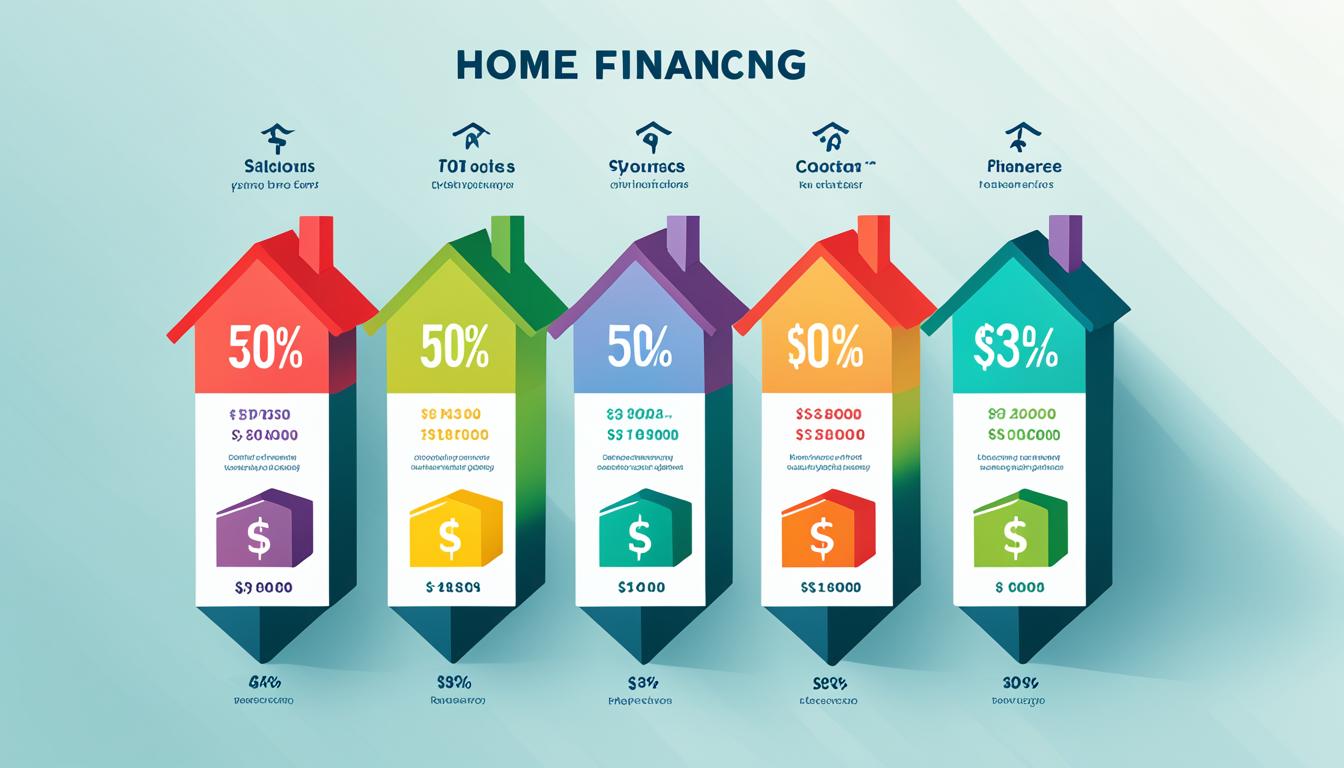Navigating the world of mortgage rates in the United States can be a daunting task, but this comprehensive guide is here to help. Whether you’re a first-time homebuyer or a seasoned homeowner looking to refinance, understanding the current trends and factors influencing mortgage rates is crucial to securing the best financing for your home.
In this article, we’ll explore the intricacies of mortgage rates, including the types of loans available, the refinancing process, and expert strategies to help you make informed decisions. From comparing rates across different lenders to understanding the impact of your credit score and down payment, we’ll provide you with the knowledge and tools you need to find the most favorable mortgage terms.
Key Takeaways
- Mortgage rates in the USA are influenced by a variety of factors, including the Federal Reserve’s monetary policy, economic indicators, and the overall housing market.
- Comparing mortgage rates from multiple lenders, including banks, online providers, and credit unions, can help you find the best deal.
- Understanding the differences between fixed-rate and adjustable-rate mortgages (ARMs) is essential in determining the right loan for your financial situation.
- Your credit score and down payment size are key factors that lenders consider when determining the interest rate you qualify for.
- Refinancing your mortgage can be a strategic move to lower your interest rate, shorten your loan term, or access home equity.
Understanding Mortgage Rates in the USA
Mortgage rates are a crucial factor in the home-buying process, determining the overall cost and affordability of a property. These rates refer to the interest charged by lenders on home loans, which can vary based on several key factors, including the type of mortgage, the borrower’s creditworthiness, and broader economic conditions.
What Are Mortgage Rates?
Mortgage rates are the annual interest rates charged by lenders on home loans. They are typically expressed as a percentage of the total loan amount and can be either fixed-rate or adjustable-rate. Fixed-rate mortgages maintain the same interest rate throughout the life of the loan, while adjustable-rate mortgages (ARMs) have interest rates that can fluctuate over time, often in response to changes in the market or the Federal Reserve’s monetary policy.
Factors Influencing Mortgage Rates
The mortgage rates in USA are influenced by a variety of factors, both at the individual and macroeconomic level. Some of the key influences include:
- Federal Reserve’s Monetary Policy: The Federal Reserve’s decisions regarding interest rates can have a direct impact on mortgage rates, as they aim to manage inflation and economic growth.
- Economic Indicators: The overall state of the economy, as reflected in factors like inflation, GDP growth, and employment levels, can affect mortgage rates.
- Mortgage Type: Fixed-rate and adjustable-rate mortgages typically have different interest rates and respond differently to market conditions.
- Borrower’s Credit Profile: A borrower’s credit score and credit history can significantly influence the mortgage rates they qualify for.
- Down Payment: The size of the down payment can also impact mortgage rates, with larger down payments often resulting in lower rates.
By understanding these key factors that influence mortgage rates in the USA, borrowers can make more informed decisions about their home financing options and secure the best possible rates for their unique financial situation.
Mortgage Rates in USA: Current Trends and Forecasts
As the housing market continues to evolve, it’s crucial for prospective homebuyers and homeowners to stay informed about the current mortgage rates in USA and the broader mortgage rate trends. This section examines the latest developments in the mortgage rate landscape, providing insights into the current mortgage rates and expert mortgage rate forecasts to help readers make informed decisions about their home financing options.
Over the past year, mortgage rates in USA have experienced significant fluctuations, responding to various economic factors and the monetary policies of the Federal Reserve. After reaching record lows during the COVID-19 pandemic, mortgage rates have gradually risen, driven by the Federal Reserve’s efforts to curb inflation and stabilize the economy. This shift has had a significant impact on the affordability of home purchases and the viability of refinancing for many homeowners.
According to leading industry experts, the mortgage rate trends are expected to continue evolving in the coming months. Mortgage rate forecasts suggest that while current mortgage rates may remain elevated compared to the historic lows, they are unlikely to reach the levels seen during previous periods of high inflation. The Federal Reserve’s ongoing policies and the overall economic climate will play a crucial role in shaping the future mortgage rate trends in the USA.
By staying informed about the current mortgage rates, mortgage rate trends, and mortgage rate forecasts, readers can make more informed decisions about the right time to purchase or refinance a home, ensuring they secure the most favorable financing options available in the market.
Comparing Mortgage Rates from Different Lenders
When it comes to securing the best mortgage rates, comparing offers from various lenders is crucial. From major banks and lending institutions to online mortgage companies and local credit unions, each type of lender can provide unique advantages and considerations for prospective homebuyers. By understanding the differences between these lenders, you can make an informed decision that aligns with your financial goals and preferences.
Major Banks and Lending Institutions
Traditional banks and large lending institutions often have the resources and market influence to offer a wide range of mortgage products, including fixed-rate and adjustable-rate options. These lenders may provide personalized service, in-house underwriting, and the ability to bundle mortgage loans with other banking services. However, their rates and fees can sometimes be higher compared to other options in the market.
Online Mortgage Lenders
The rise of online mortgage lenders has transformed the home financing landscape, offering a convenient and potentially more affordable alternative to traditional banks. These digital-first companies often have lower overhead costs, which can translate to more competitive mortgage rates from lenders and a streamlined application process. By comparing mortgage rates from multiple online lenders, borrowers may be able to find a better deal.
Credit Unions and Local Banks
Credit unions and community-based banks can be an attractive option for homebuyers seeking personalized attention and potentially lower mortgage rates. These lenders often have a deep understanding of the local market and may be more willing to work with borrowers who have unique financial circumstances or credit profiles. Additionally, credit unions are known for their member-centric approach, which can translate to more favorable terms and customer service.
When comparing mortgage rates from different lenders, it’s important to consider not only the interest rate but also the associated fees, closing costs, and any special programs or incentives offered. By carefully evaluating the options from various banks, online lenders, and credit unions, you can make an informed decision that sets you up for long-term financial success.
Types of Mortgage Loans and Interest Rates
When it comes to financing a home, borrowers have two primary options: fixed-rate mortgages and adjustable-rate mortgages (ARMs). Understanding the key features, advantages, and disadvantages of each type can help homebuyers make an informed decision that aligns with their financial goals and preferences.
Fixed-Rate Mortgages
A fixed-rate mortgage offers a consistent interest rate throughout the entire loan term, which is typically 15 or 30 years. This means that the monthly payments for principal and interest remain the same, providing stability and predictability for the borrower. Fixed-rate mortgages are a popular choice for homeowners who value financial certainty and want to lock in their interest rates, particularly in a rising interest rate environment.
Adjustable-Rate Mortgages (ARMs)
In contrast, an adjustable-rate mortgage (ARM) features an interest rate that can fluctuate over the life of the loan. ARMs typically have an initial fixed-rate period, followed by periodic adjustments based on a specified index, such as the U.S. Prime Rate or the London Interbank Offered Rate (LIBOR). This means that the monthly payments can increase or decrease over time, depending on market conditions. ARMs may offer lower initial interest rates compared to fixed-rate mortgages, but the potential for rising payments in the future should be carefully considered by borrowers.
| Feature | Fixed-Rate Mortgage | Adjustable-Rate Mortgage (ARM) |
|---|---|---|
| Interest Rate Structure | Consistent interest rate throughout the loan term | Interest rate can fluctuate over the life of the loan |
| Monthly Payments | Stable and predictable | Can increase or decrease over time |
| Suitability | Preferred by borrowers seeking financial stability | Suitable for borrowers willing to accept interest rate risk |
| Typical Loan Terms | 15 or 30 years | Initial fixed-rate period followed by periodic adjustments |
Ultimately, the choice between a fixed-rate mortgage and an adjustable-rate mortgage depends on the borrower’s financial situation, risk tolerance, and long-term goals. Careful consideration of the interest rate structure, monthly payment fluctuations, and the overall loan terms can help homebuyers select the most suitable mortgage option for their needs.
Factors to Consider When Choosing a Mortgage Rate
When it comes to securing a mortgage, several personal and financial factors can significantly influence the interest rate you qualify for. Two of the most crucial elements are your credit score and credit history, as well as your down payment and loan-to-value ratio.
Credit Score and Credit History
Your credit score is a primary factor that lenders evaluate when determining your mortgage rate. A higher credit score, typically 740 or above, can unlock more favorable interest rates and better loan terms. Conversely, a lower credit score may result in higher mortgage rates or even difficulty securing a loan altogether. Lenders also closely examine your credit history, looking for patterns of responsible financial management, such as on-time bill payments and low debt-to-income ratios.
Down Payment and Loan-to-Value Ratio
The size of your down payment and the resulting loan-to-value (LTV) ratio can also have a significant impact on your mortgage rate. Generally, a larger down payment of 20% or more can help you qualify for lower interest rates and more favorable loan terms. Conversely, a smaller down payment, leading to a higher LTV ratio, may result in higher mortgage rates and the need for private mortgage insurance (PMI).
By understanding how these factors are evaluated by lenders, you can make more informed decisions about your home financing, ultimately securing the most favorable mortgage rates that align with your financial goals and long-term plans.
Strategies for Getting the Best Mortgage Rates
Securing the best possible mortgage rates requires proactive strategies. In this section, we’ll explore two key approaches: improving your credit score and shopping around with multiple lenders.
Improving Your Credit Score
Your credit score is a crucial factor that lenders consider when determining the interest rate you’ll qualify for. By taking steps to improve your credit score, you can unlock access to the best mortgage rates available. Start by reviewing your credit report for any errors or discrepancies, and work on paying down outstanding debts, making timely payments, and maintaining a healthy credit utilization ratio.
Shopping Around and Negotiating
Don’t settle for the first mortgage rate offered to you. Instead, shop around with multiple lenders to compare rates, fees, and terms. This competitive research will give you the leverage to negotiate for the most favorable mortgage rates and terms. Be prepared to provide your financial information, credit profile, and desired loan details to each lender, and don’t be afraid to use competing offers as a bargaining chip.
| Strategy | Impact on Mortgage Rates |
|---|---|
| Improve Credit Score | A higher credit score can unlock access to the best mortgage rates, potentially saving you thousands in interest over the life of the loan. |
| Shop Around and Negotiate | By shopping for mortgage rates and negotiating with multiple lenders, you can secure the most competitive mortgage rates tailored to your specific financial situation. |
Remember, taking a proactive approach to improving your creditworthiness and negotiating mortgage rates can make a significant difference in the long-term affordability of your home loan.

Refinancing: When and How to Do It
Refinancing your mortgage can be a strategic financial move that can provide significant benefits, such as lowering your interest rate, shortening your loan term, or accessing the equity in your home. However, it’s important to carefully consider the reasons and the process involved to determine if refinancing is the right choice for your unique situation.
Reasons to Refinance Your Mortgage
The most common reasons to refinance your mortgage include reducing your interest rate, which can lead to lower monthly payments and significant long-term savings. Another reason is to shorten the loan term, which can help you pay off your mortgage faster and build equity more quickly. Some homeowners also opt to refinance in order to access their home equity through a cash-out refinancing, which can provide funds for home improvements, debt consolidation, or other financial goals.
The Refinancing Process
The refinancing process typically involves several steps, including obtaining a new appraisal of your home, submitting updated financial documentation, and going through the underwriting and closing process. It’s important to carefully review the terms of the new loan, including the interest rate, loan fees, and closing costs, to ensure that refinancing is a financially beneficial decision for your situation. Additionally, be prepared to provide documentation such as pay stubs, tax returns, and proof of homeowner’s insurance during the refinancing process.
By understanding the reasons to refinance and the steps involved, you can make an informed decision about whether refinancing is the right choice for you. Carefully evaluating your financial goals and working closely with a reputable lender can help ensure a smooth and successful refinancing experience.








1 comment